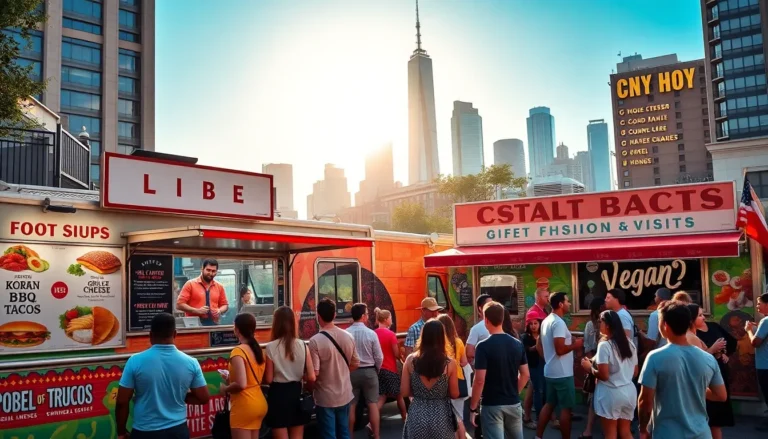In a world where kale is the new queen, vegan food trends are taking the culinary scene by storm. Gone are the days when plant-based eating was synonymous with bland salads and tofu confusion. Now, it’s all about mouthwatering flavors that even meat-lovers can’t resist. If you think vegan food is just a passing fad, think again. Let’s explore how plant-based diets are not only rising but thriving, alongside some revolutionary ingredients you wouldn’t expect to find on a vegan menu.
Table of Contents
ToggleThe Rise of Plant-Based Diets

The plant-based movement is in full swing, and it’s not merely a trend: it’s a lifestyle that’s here to stay. With more and more people becoming aware of the environmental, health, and ethical impacts of their food choices, plant-based diets have surged in popularity. According to recent studies, nearly 1 in 4 Americans now identify as flexitarians, showing a significant shift towards reducing meat consumption. This growth is supported by a plethora of documentaries, influencer endorsements, and social media buzz showcasing not just health benefits but also delectable vegan recipes. The vegan demographic is changing too: it’s no longer just limited to the health-conscious millennials but includes families, professionals, and even culinary chefs eager to experiment with vibrant, plant-based options.
Also, ventures into grocery stores have transformed. Shelves are now stocked with innovative vegan products that make the transition to a plant-based lifestyle easier than ever. Not only that, but dining out has become an adventure, with many restaurants boasting entire vegan menus. The rise of plant-based diets isn’t just a personal choice: it’s a cultural shift that emphasizes sustainability, diversity, and culinary creativity.
Innovative Vegan Ingredients
Vegan food isn’t just about beans, greens, and grains anymore. Today, it’s filled with innovative ingredients that redefine what a plant-based meal can be. For example, jackfruit is taking the spotlight as a meat substitute with its meaty texture and ability to soak up flavors, making it perfect for vegan tacos or pulled ‘pork.’ Similarly, aquafaba, the liquid from canned chickpeas, has emerged as a miraculous egg white replacement for whipping up fluffy meringues and even mayonnaise.
Then there’s nutritional yeast, affectionately called ‘nooch’ by its fans, which adds a cheesy flavor to sauces and popcorn without dairy. For those craving something a little sweeter, products like coconut yogurt and almond-based cheeses are perfect indulgences without compromising on taste. These innovative ingredients make it easier than ever for anyone to whip up a delicious, cruelty-free meal at home.
Vegan Comfort Foods Taking Center Stage
Who said comfort food has to be heavy on the meat or dairy? Vegan comfort foods are not just an afterthought: they are taking center stage in the culinary world. Think creamy mac and cheese made with cashews or decadent chocolate cake that’s dairy-free yet irresistibly moist. Foodies everywhere are falling head over heels for vegan twists on classic comfort dishes.
Also, companies are pouring resources into research and development to mimic beloved traditional tastes. Burgers made from pea protein are sizzling on grills, while dairy-free ice creams featuring nut milks provide guilt-free sweet relief. Bakeries popping up with entirely vegan menus are turning heads with desserts that even the staunchest omnivores can’t resist, proving that satisfaction doesn’t require animal products.
Sustainable and Locally Sourced Vegan Options
As environmental consciousness rises, sustainably sourced vegan options are in hot demand. Consumers are more educated about where their food comes from and the carbon footprint it leaves behind. This has led to a boom in local farming and community-supported agriculture, where food travels shorter distances from farm to table.
More restaurants and grocery stores are proudly showcasing local produce and ethically sourced ingredients, making sustainability a top priority. This trend not only supports local economies but reduces overall carbon emissions, contributing to a more environmentally friendly food system. Eating vegan can go hand-in-hand with eating local, allowing people to enjoy vibrant, seasonally available foods while feeling good about their choices.
Vegan Meal Prep and Convenience Foods
In today’s fast-paced world, convenience is key, and vegan meal prep is gaining traction. Busy professionals and families are looking for easy solutions that don’t compromise on taste or nutrition. Ready-to-eat vegan meals, prepped ingredient packs, and quick-cooking products are popping up everywhere, making plant-based eating accessible for everyone.
Companies are now catering to the demand for vegan convenience foods, from microwaveable vegan bowls to frozen meals that taste delicious and satisfying. Plant-based snacks, like roasted chickpeas or kale chips, are perfect for on-the-go munchies. Meal prep kits are also gaining popularity, providing everything from recipes to grocery lists, making a plant-based lifestyle not only attainable but enjoyable.
The Influence of Global Cuisines on Vegan Dishes
Vegan cuisine is evolving by embracing global influences that inspire exciting flavors and textures. Cuisines from around the world, such as Indian, Thai, and Mediterranean, offer rich, flavorful options that are naturally vegan or can be easily adapted. For instance, lentil curries filled with spices awaken the taste buds while being completely plant-based.
Exploring global cuisines also introduces ingredients previously overlooked in vegan meals. Like the stunning variety of beans, legumes, and grains featured in traditional dishes across cultures adds depth to vegan cooking. Vegan foods are no longer bland or monotonous: they reflect a beautiful tapestry of flavors celebrating diversity and creativity in kitchens everywhere.


